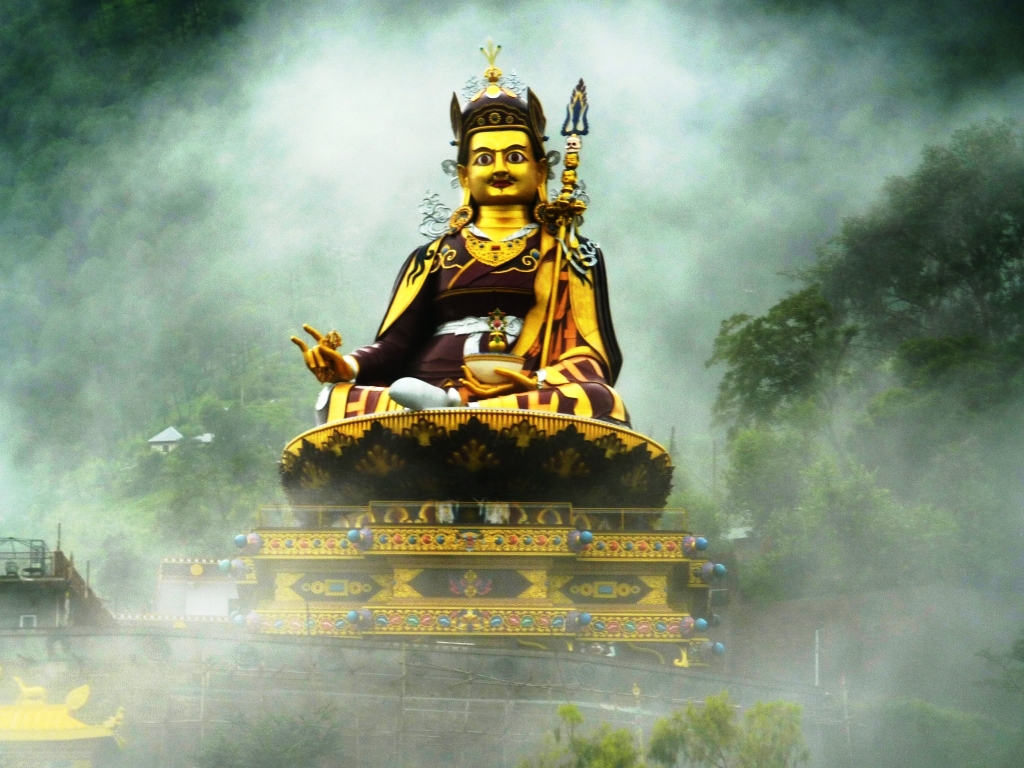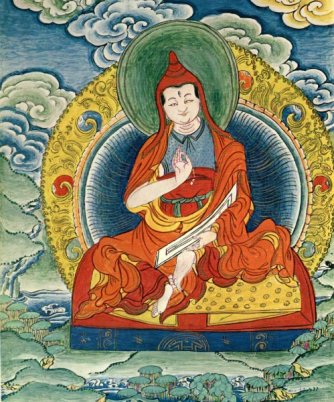|
Lotsawa
Lotsawa () is a Tibetan title used to refer to the Nyingma's ''Ancient Translation School'' of 108 Tibetan translators, which include Vairotsana, Rinchen Zangpo, Marpa Lotsawa, Tropu Lotsawa Jampa Pel and many others. They worked alongside Indian scholars, or panditas, to prepare the first translation into the Tibetan language of the Kangyur and Tengyur of the Buddhist Canon, from original texts written in Pali, Sanskrit, Classical Chinese, Buddihist Hybrid Sanskrit and other Asian languages. Working under the direction of Padmasambhava and Shantarakshita in the 8th century, their patron was King Trisong Detsen. The term is also used to refer to modern-day translators of Tibetan Buddhist texts. Lotsawa is thought to derive from the Sanskrit word '' licchavi'', a privileged ancient and medieval Indo-Aryan tribe and dynasty. TAnother theory has it that the term is a transliteration of the Sanskrit compound ''lokacakṣu'', literally "eye of the world" or more symbolica ... [...More Info...] [...Related Items...] OR: [Wikipedia] [Google] [Baidu] |
Padmasambhava
Padmasambhava ('Born from a Lotus'), also known as Guru Rinpoche ('Precious Guru'), was a legendary tantric Buddhist Vajracharya, Vajra master from Oddiyana. who fully revealed the Vajrayana in Tibet, circa 8th – 9th centuries... He is considered an emanation or Nirmāṇakāya of Gautama Buddha, Shakyamuni Buddha as foretold by the Buddha himself. According to early Tibetan sources including the ''Testament of Ba'', he came to Tibet in the 8th century and designed Samye Monastery, the first Buddhist monastery in Tibet during the reign of King Trisong Detsen. He, the king, and Khenpo Shantarakshita are also responsible for creating the Tibetan canon, Tibetan Canon through translating all of the Buddha's teachings and their commentaries into the Tibetan language. According to Lewis Doney, while his historical authenticity was questioned by earlier Tibetology, Tibetologists, it is now "cautiously accepted.” Padmasambhava himself was recorded as saying he was an historical per ... [...More Info...] [...Related Items...] OR: [Wikipedia] [Google] [Baidu] |
Marpa Lotsawa
Marpa Lotsāwa (, 1012–1097), sometimes known fully as Marpa Chökyi Lodrö ( Wylie: mar pa chos kyi blo gros) or commonly as Marpa the Translator (Marpa Lotsāwa), was a Tibetan Buddhist teacher credited with the transmission of many Vajrayana teachings from India, including the teachings and lineages of Mahamudra. Due to this, the Kagyu lineage, which he founded, is often called Marpa Kagyu in his honour.samye.orgThe Kagyu Lineage: the Tibetan Lineage Masters: Marpa the Translator/ref> Although some accounts relate that the Mahasiddha Naropa was the personal teacher of Marpa, other accounts suggest that Marpa held Naropa's lineage through intermediary disciples only. Either way, Marpa was a personal student of the Mahasiddha Maitripa and of the dakini Niguma. Biography Born as Marpa Chökyi Lodrö, in Lhodrak Chukhyer in the southern part of Tibet, to an affluent family, he began studying at a young age but was wild and untamed compared to other children. Marpa first rece ... [...More Info...] [...Related Items...] OR: [Wikipedia] [Google] [Baidu] |
Vairotsana
Vairotsana () was a lotsawa or "translator" living during the reign of King Trisong Detsen, who ruled 755-97 CE. Vairotsana, one of the 25 main disciples of Padmasambhava, was recognized by the latter as a reincarnation of an Indian pandita. He was among the first seven monks ordained by Śāntarakṣita, and was sent to Dhahena in India to study with Śrī Siṅgha, who taught him in complete secrecy. Śrī Siṅgha in turn entrusted Vairotsana with the task of propagating the semde and longdé sections of Dzogchen in Tibet. He is one of the three main masters to bring the Dzogchen teachings to Tibet, the two others being Padmasambhava and Vimalamitra, and was also a significant lineage holder of trul khor. Shechen Gyaltsab mentions in his ''Pond of White Lotus Flowers'' that before meeting Śrī Siṅgha, Vairotsana had met the wisdom forms of the two vidyadharas Garab Dorje and Mañjuśrīmitra in a miraculous pagoda at Dhahena. After he had presented a huge off ... [...More Info...] [...Related Items...] OR: [Wikipedia] [Google] [Baidu] |
Buddhist Hybrid Sanskrit
Buddhist Hybrid Sanskrit (BHS) is a modern linguistic category applied to the language used in a class of Indian Buddhist texts, such as the Perfection of Wisdom sutras. BHS is classified as a Middle Indo-Aryan language. It is sometimes called "Buddhist Sanskrit" or "Mixed Sanskrit". Origin Prior to Buddhist hybrid Sanskrit teachings used to be generally recorded in the Pali language. Pali language was common at the time of the Buddha. His teachings were apparently first found in Pali language written by Theravada buddhists. Buddhist hybrid Sanskrit became the pre-eminent language for literature and philosophy in India. Buddhist monks developed this language they used to it while remaining under the influence of a linguistic tradition stemming from the proto-canonical Prakrit of the early oral tradition.Edgerton, Franklin. ''The Prakrit Underlying Buddhistic Hybrid Sanskrit.'' Bulletin of the School of Oriental Studies, University of London, Vol. 8, No. 2/3, page 503. While ... [...More Info...] [...Related Items...] OR: [Wikipedia] [Google] [Baidu] |
Translators To Tibetan
Translation is the communication of the semantics, meaning of a #Source and target languages, source-language text by means of an Dynamic and formal equivalence, equivalent #Source and target languages, target-language text. The English language draws a terminological distinction (which does not exist in every language) between ''translating'' (a written text) and ''interpreting'' (oral or Sign language, signed communication between users of different languages); under this distinction, translation can begin only after the appearance of writing within a language community. A translator always risks inadvertently introducing source-language words, grammar, or syntax into the target-language rendering. On the other hand, such "spill-overs" have sometimes imported useful source-language calques and loanwords that have enriched target languages. Translators, including early translators of sacred texts, have helped shape the very languages into which they have translated. Becau ... [...More Info...] [...Related Items...] OR: [Wikipedia] [Google] [Baidu] |
Tibetan Buddhist Titles
Tibetan may mean: * of, from, or related to Tibet * Tibetan people, an ethnic group * Tibetan language: ** Classical Tibetan, the classical language used also as a contemporary written standard ** Standard Tibetan, the most widely used spoken dialect ** Tibetan pinyin, a method of writing Standard Tibetan in Latin script ** Tibetan script ** any other of the Tibetic languages Tibetan may additionally refer to: Culture * Old Tibetan, an era of Tibetan history * Tibetan art * Music of Tibet * Tibetan rug * Tibetan culture * Tibetan cuisine Religion * Tibetan Buddhism * Tibetan Muslims Other uses * Tibetan alphabet * Tibetan (Unicode block) * Tibetan name * Tibetan calendar * Tibetan Spaniel, a breed of dog * Tibetan Mastiff, a breed of dog See also * Tibet (other) * Tibetan Bells (other) * Traditional Tibetan medicine * Tibetan language (other) Tibetan language may refer to: * Lhasa Tibetan or Standard Tibetan, the most widely used spoken dialect * ... [...More Info...] [...Related Items...] OR: [Wikipedia] [Google] [Baidu] |
Yudra Nyingpo
Yudra Nyingpo () was one of the chief disciples of Vairotsana and one of the principal lotsawa "translators" of the first translation stage of texts into Tibetan. Yudra Nyingpo became one of the greatest masters of Nyingma Dzogchen Semde and Longdé teachings: Yudra Nyingpo was a prince of Gyalmo Tsawe Rong (Gyarong) in Eastern Tibet. In Gyarong, Yudra Nyingpo received teachings from Vairocana, who was exiled in the area for a certain period of time. Studying with Vairocana, Yudra Nyingpo became a great scholar and translator. Later he traveled to Central Tibet and received teachings from Guru Rinpoche and he became one of the greatest masters of semde and longdé teachings of Dzogpa Chenpo in Tibet. Yudra Nyingpo translated many works, including the 'Thirteen Later Translations' () of the 'Eighteen Major Scriptural Transmissions of the Mind Series' (): #Tsemo Chung-gyal (Supreme Peak) () #Namkha'i Gyalpo (King of Space) () #Dewa Thrulkod (Jewel-Encrusted Bliss Ornament) () #Dzo ... [...More Info...] [...Related Items...] OR: [Wikipedia] [Google] [Baidu] |
Tibetan & Himalayan Digital Library
The Tibetan and Himalayan Library (THL), formerly the Tibetan and Himalayan Digital Library (THDL), is a multimedia guide and digital library hosted by the University of Virginia focused on the languages, history and geography of Tibet and the Himalayas. The THL has also designed a scholarly transcription for Standard Tibetan known as the THL Simplified Phonetic Transcription. Overview THDL was established in 2000 in association with the University of Virginia Library and the Institute for Advanced Technology in the Humanities, using the innovative Fedora Commons (Flexible Extensible Digital Object Repository Architecture) system. Content includes publications, research resources, language learning materials, and a gazetteer. THDL provides "an integrated environment for the digital publication of many diverse academic projects connected with Tibet and the Himalayan region". The structure of THDL consists of five overarching domains: Collections, Reference, Community, Tools, and ... [...More Info...] [...Related Items...] OR: [Wikipedia] [Google] [Baidu] |
Jnanasutra
There appear to be two Jnanasutras, with different Tibetan orthographies for their names. The first, , flourished from the 5th-6th centuries. According to Dzogchen legends, he was an early Dzogchen practitioner of Vajrayāna Buddhism and a disciple of Sri Singha. This Jnanasutra was a spiritual brother of Vimalamitra, another principal disciple of Sri Singha. According to Tarthang Tulku (1980), the second ''Jnanasutra'' was the principal lotsawa () of the 8th-9th century of the first wave of translations from Sanskrit to Tibetan.Rhaldi, Sherab (undated). 'Ye-Shes-sDe; Tibetan Scholar and Saint'. ''Tibetan & Himalayan Digital Library''. Source(accessed: Wednesday April 1, 2009) In Jigme Lingpa's terma of the ngöndro In Tibetan Buddhism, Ngöndro (, ) refers to the preliminary, preparatory or foundational practices or disciplines (Sanskrit: sādhanā) common to all four schools of Tibetan Buddhism and also to Bon. They precede deity yoga. The preliminary pr ... of the Lon ... [...More Info...] [...Related Items...] OR: [Wikipedia] [Google] [Baidu] |
Licchavi (other) , ruled Nepal beginning in the 4th century CE
{{Disambig ...
Licchavi can refer to two historic states in South Asia: * Licchavis of Vaishali, original branch of the tribe based in Vaishali, Bihar *Licchavis of Nepal The Licchavis of Nepal (, also ''Lichchhavi'', ''Lichavi'') ruled over a kingdom in the Kathmandu Valley of Nepal from approximately 450 to 750 CE. The Licchavi clan originated from a branch of the Licchavis of Vaishali who ruled in the ter ... [...More Info...] [...Related Items...] OR: [Wikipedia] [Google] [Baidu] |
Trisong Detsen
Trisong Detsen () was the son of Me Agtsom, the 37th king of Tibet. As the 38th king, he ruled from AD 755 until 797. Trisong Detsen was the second of the Three Dharma Kings of Tibet — Songsten Gampo, Trisong Detsen, Rapalchen — honored for their pivotal roles in the introduction of Buddhism to Tibet and the establishment of the Nyingma or "Ancient" school of Tibetan Buddhism. ''Sowa Rigpa'' or Traditional Tibetan medicine was developed during his reign. Trisong Detsen became one of Tibet's greatest kings during its empire era, and an unparalleled Buddhist benefactor to Guru Padmasambhava, to Khenpo Shantarakshita, to his court, and to the founding of the Vajrayana. By the end of his reign, he grew the extents of Tibet beyond their previous borders, reset the borders between Tibet and China in 783, and even occupied the capital of China at Chang'an, where he installed a king. Claude Arpi, ''Glimpses of the Tibet History'', Dharamsala: The Tibet Museum, 2016, Chapter 6, "A ... [...More Info...] [...Related Items...] OR: [Wikipedia] [Google] [Baidu] |




